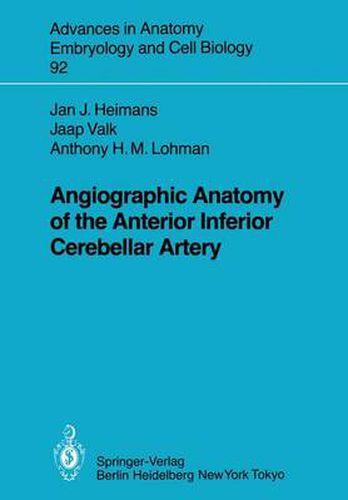Readings Newsletter
Become a Readings Member to make your shopping experience even easier.
Sign in or sign up for free!
You’re not far away from qualifying for FREE standard shipping within Australia
You’ve qualified for FREE standard shipping within Australia
The cart is loading…






This title is printed to order. This book may have been self-published. If so, we cannot guarantee the quality of the content. In the main most books will have gone through the editing process however some may not. We therefore suggest that you be aware of this before ordering this book. If in doubt check either the author or publisher’s details as we are unable to accept any returns unless they are faulty. Please contact us if you have any questions.
The anterior inferior cerebellar artery (AI CA) is one of the major branches of the basilar artery and supplies part of the pons, the upper medulla, and the cerebellar hemisphere. The artery can be visualized by means of vertebral angiography. This technique of examination was carried out for the first time in 1933 by Moniz and co-workers (Moniz and Alves 1933, Moniz et al. 1933). During the decades that followed, angiographic techniques improved considera bly, with the result that more details of the angioarchitecture of the posterior cranial fossa could be demonstrated. Satisfactory visualization of the AICA and its branches depends greatly on the use of subtraction, and this is the reason why detailed reports on the angiographic appearance of the artery were for the greater part published after 1965, when subtraction techniques were more consistently used (Takahashi et al. 1968, 1974; Gerald et al. 1973). The angiographic appearance of the various segments of the AICA in the lateral projection, both in the normal situation and in the presence of tumors, has been studied by Naidich et al. (1976a, b). The primary aim was to recognize and denominate the separate branches, loops, and segments of the AICA in order to locate tumors on the basis of displacements of portions of the artery. The fact that the course, caliber, and distribution of the AICA are very variable was not emphasized.
$9.00 standard shipping within Australia
FREE standard shipping within Australia for orders over $100.00
Express & International shipping calculated at checkout
This title is printed to order. This book may have been self-published. If so, we cannot guarantee the quality of the content. In the main most books will have gone through the editing process however some may not. We therefore suggest that you be aware of this before ordering this book. If in doubt check either the author or publisher’s details as we are unable to accept any returns unless they are faulty. Please contact us if you have any questions.
The anterior inferior cerebellar artery (AI CA) is one of the major branches of the basilar artery and supplies part of the pons, the upper medulla, and the cerebellar hemisphere. The artery can be visualized by means of vertebral angiography. This technique of examination was carried out for the first time in 1933 by Moniz and co-workers (Moniz and Alves 1933, Moniz et al. 1933). During the decades that followed, angiographic techniques improved considera bly, with the result that more details of the angioarchitecture of the posterior cranial fossa could be demonstrated. Satisfactory visualization of the AICA and its branches depends greatly on the use of subtraction, and this is the reason why detailed reports on the angiographic appearance of the artery were for the greater part published after 1965, when subtraction techniques were more consistently used (Takahashi et al. 1968, 1974; Gerald et al. 1973). The angiographic appearance of the various segments of the AICA in the lateral projection, both in the normal situation and in the presence of tumors, has been studied by Naidich et al. (1976a, b). The primary aim was to recognize and denominate the separate branches, loops, and segments of the AICA in order to locate tumors on the basis of displacements of portions of the artery. The fact that the course, caliber, and distribution of the AICA are very variable was not emphasized.